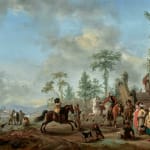Philips Wouwerman (1619-1668)
As the most accomplished and successful seventeenth-century Dutch painter of equestrian subjects, Wouwerman was adept at depicting horses in many different contexts and settings. Scenes featuring richly attired figures attended by pages, grooms and dogs, provided the artist with a favorite source of subject matter during the 1650s and 1660s. It is not surprising therefore that on numerous occasions Wouwerman was drawn to paint the theme of the riding school, appealing as it did to his talents as a painter of horses and people. Birgit Schumacher in her catalogue raisonné devoted to the artist dates the present painting to the end of the 1650s. Schumacher lists some twenty riding school paintings made over a period of nearly two decades.
Described by Hofstede de Groot as one of the finest pictures of the artist’s maturity, our painting of a riding school shows to brilliant effect Philips Wouwerman’s consummate skill in depicting equestrian subjects. It once belonged to the French financier and celebrated connoisseur Pierre Crozat, one of the greatest private collectors of the eighteenth century and the principal patron of Antoine Watteau.[1] The provenance of this painting increased in prestige when in 1772 it was acquired en bloc with the entire Crozat collection by Catherine the Great of Russia (1729–1796). There it remained in imperial possession, first at the palace of Tsarskoe-Selo and later at the Hermitage in Saint Petersburg, until the collections were dispersed by the Soviet Government.
Wouwerman’s reputation continued to grow posthumously throughout the eighteenth century and his work was avidly collected by connoisseurs who appreciated his technical perfection and elegant subject matter. His pictures were particularly prized in France, where many of his compositions, including this one, were engraved. A not dissimilar horseman appears in Karen Kilimnik’s Jack Straw the highway man although this drawing references the British Peasants’ Revolt of 1381.
[1] M. Stuffmann, ‘Les Tableaux de la collection de Pierre Crozat’, Gazette des beaux-arts, vol. 72, 1968, pp. 11–144; see also H. Meyer, ‘La collection de Louis-Antoine Crozat, baron de Thiers’, in L’Age d’or flamand et hollandais: Collections de Catherine II, Musée de l’Ermitage, Saint-Pétersbourg, exh.cat., Musée des Beaux-Arts de Dijon, 1993, pp. 49–56
Provenance
Possibly with an art dealer in Antwerp around 1700
Pierre Crozat (1665–1740), Paris, by inheritance to his nephew
Louis-Antoine Crozat, Baron de Thiers (1699-1770), Paris, probably in 1740 but by 1756, by descent, sold together with the entire Crozat collection to
Catherine the Great of Russia (1729–1796), 1772
At Tsarskoe-Selo, near Saint Petersburg, hanging in the Dairy House, 1842
At the Hermitage Palace, Saint Petersburg, inv.no. 996, 1901–1928
Sold anonymously, presumably on behalf of the government of the USSR, Berlin, Ball & Graupe, 28 June 1932, lot 42
Private collection, Europe
With Richard Green, London, 1985–1986
Private collection, Germany
Their sale, New York, Sotheby’s, 23 January 2003, lot 40, for $550,000
Private Collection
With Adam Williams Fine Art, New York
Exhibitions
London, Richard Green Gallery, Exhibition of Old Master and Impressionist Paintings, 1986, no. 8, ill.
Literature
J. Moyreau, Œuvres de Ph.pe Wouvermens, hollandois: gravées d'après ses meilleurs tableaux qui sont dans les plus beaux cabinets de Paris et ailleurs, Paris 1737–62 (1756), pl. 82
J. Smith, A Catalogue Raisonné…, vol. I, London 1829, p. 303, no. 359
J. Smith, A Catalogue Raisonné…, Supplement, vol. IX, London 1842, p. 159, no. 61 (as “Showing-off Horses... excellent picture... Worth 450 gs.”)
Hermitage Palace, Catalogue, Saint Petersburg 1901, no. 996
C. Hofstede de Groot, A Catalogue Raisonné of the Works of the Most Eminent Dutch Painters of the Seventeenth Century, vol. II, London 1909, p. 271, no. 55
B. Schumacher, Studien zu Werk und Wirkung Philips Wouwermans, diss., Munich 1989, pp. 104, 287, no. 148
B. Schumacher, Pferde, Meisterwerke des Pferde- und Reiterbildes, Stuttgart 1994, reproduced in colour on pp. 146 and 141 (detail)
B. Schumacher, Philips Wouwerman (1619–1668). The Horse Painter of the Golden Age, 2 Vols., Doornspijk 2006, vol. I, p. 176, A18, reproduced in color, vol. II, plates 7 & 17
ENGRAVED
In reverse for Jean Moyreau (1690–1762), as L’Ecuyer du Manège, in the Cabinet Crozat de Thiers, published 1756



